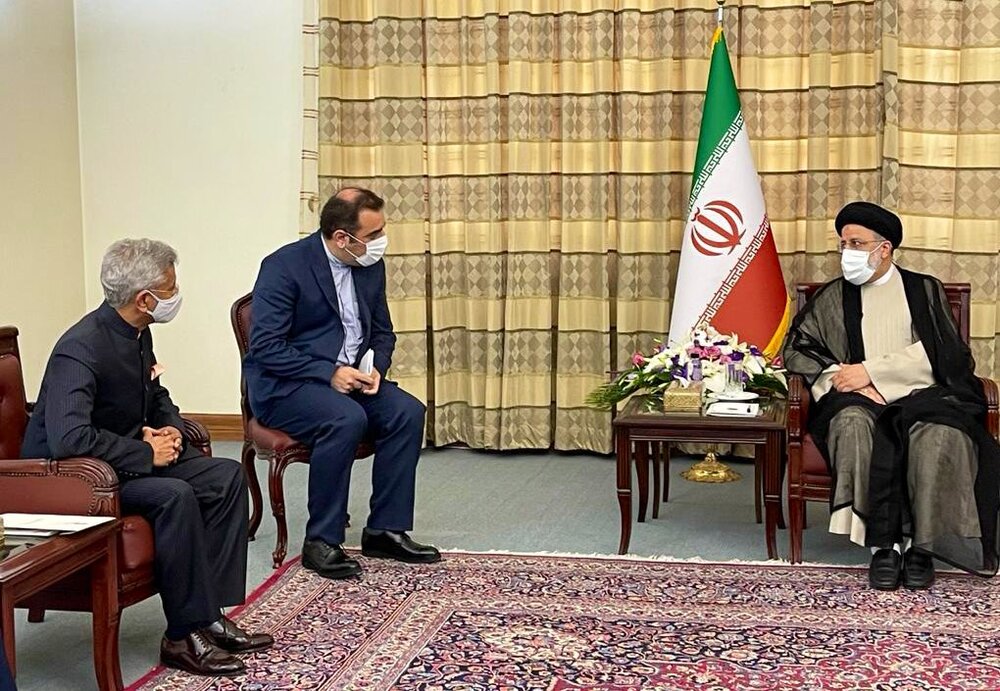Jaishankar-Raisi meet in Tehran

Soon after the news of Iranian Judiciary head Ebrahim Raisi’s landslide victory reached New Delhi, India’s Prime Minister Narendra Modi promptly shot a tweet to congratulate the president-elect.
India was not just among the first states to convey the warm greetings to Raisi but it was first to send her envoy-in-chief to meet and greet President-elect Raisi. During a transit halt in Tehran, on his way to Moscow, India’s External Affairs Minister S Jaishankar called on Raisi on July 7 to hand over a unique and unprecedented hand-written congratulatory greeting from Prime Minister Modi.
Iran’s value and diplomatic acceptance in India’s foreign policy is reflected through several acts of top Indian supremos, their frequent sojourns to Iran and high-level close doors on the sidelines of multilateral rounds. Within the last one and half years, Jaishankar visited Iran thrice. Last year in September 2020, Jaishankar and Indian Defense Minister Rajnath Singh both travelled to Tehran within a week.
Foreign Minister Jaishankar’s last hurried visit to Tehran coincided with the high-level talks of Afghan delegations in the capital of Persian Gulf nation. In an official communique, Iran said, Jaishankar thanked Iran for its efforts for bringing the Afghan government and the Taliban closer. With the Indian prime minister quick congratulatory message and Jaishankar’s trip, India has clearly expressed her zest and zeal to work closely with Raisi, who will replace President Rouhani on August 5.
Bearing easy transport, free insurance, easier payment methods and refinery machine-related concerns in mind, India preferred Iran to import oil over others. The demand of oil is rising in the third largest oil consumer of the world India every year. India fulfills 80 percent of her requirements through imports from Saudi Arabia, Iraq and Iran. Till three years back, Iran was the third largest supplier of crude oil to India. But when the Trump administration began raising eyebrows over sanction causes, New Delhi temporarily scaled back importing crude oils from Iran temporarily from May 2019. It all started when the U.S. under the Trump administration jettisoned the nuclear deal with Iran in 2018.
Needless to say that 123 Civil Nuclear deal brought New Delhi and Washington closer than ever. An arrogant Trump’s presidency didn’t affect India’s bonhomie with the U.S. On the other hand, India’s adoration for Israel is rising and rising under Modi. Moreover, Iranian leadership admonished India’s decision of emasculating the special right of Kashmir.
However, India has a high hope to make Iran the gateway to Central Asia. Once Chabahar turns a reality, a smooth passage will be built and India’s trade with Eurasia can be expected to cross the $170 billion mark. Of course, Iran will win a fortune. India has already completed the initial phase of Chabahar Port and immediate next ambition is to establish a railway connectivity between the southeastern peninsular cities with Zahedan. This connectivity link is destined to widen the path of Iran’s prosperity as well. The emergence of a pent lateral strategic alliance consisting of mighty Russia, fast-marching China, ambitious Turkey, India’s neighbor Pakistan, and sanction-torn Iran will dismay India. Politically, economically and after all, strategically.
Apart from the biggest market and civilian concerns, a slew of grounds are there in front of Tehran to warm up bilateral relations with the South Asian legend. India and Iran both have mutual clubs like Indian Ocean Rim Association and Indian Ocean Naval Symposium through which they can mitigate maritime security related challenges, boost up the blue economy and maritime connectivity.
Iran is well-aware of India’s importance and India relies on Iran. The civilization-link is survived, despite differences in the styles and functions of these two ambitious republics. Not sure, how many Persian words are adopted in Indian tongues or how many Bollywood movies have entertained the Iranian society.
At the very initial phase of the COVID pandemic, President Hassan Rouhani sought help from the Indian prime minister. Iran reciprocated the help by sending oxygen concentrators and other medical aid, when the catastrophe hit India earlier this year.
Whereas Iran imports cereals, tea leaves and coffee, chemicals as well as spices in big consignments from India, India’s import dependency on Iran rests on crude oil, petrochemicals and fertilizers.
India, world's most pluralistic secular democracy has been the habitat of millions of Shia Muslims. They are spread across the states right from Kashmir in the north to down south Hyderabad or Tamil Nadu. Iran and India set up the Indo-Iran Joint Commission in 1983. An MOU called Tehran Declaration 2001 was inked by the duo on the Afghan affairs. When Iran sells oil at dirt cheap prices, India witnesses petrol prices reaching all-time highest, irking the bulky middle-class citizens in the country. The bilateral trade is unusually low, which can easily cross the $10 billion mark once the preferential trade agreement comes into effect.
In the post-COVID century, Iran and India should come into normal terms to fulfill their respective domestic needs and fostering economies via trade. India's envoy at the UN has clarified India's stance to support the effective implementation of the Joint Comprehensive Plan of Action and Resolution 2231. The ongoing Vienna nuclear deal talks started in April 2021 is the ray of hope mending ties between two opponents: Washington and Tehran. Washington’s full return to the JCPOA and Iran’s compliance with the terms of the agreement will not just be a sigh of relief for India but an avenue for Indo-Iranian bilateral bonhomie and trade as well.
Ayanangsha Maitra is a Indian freelance journalist, PhD researcher and associated to Centre for Governance Studies, Bangladesh.
